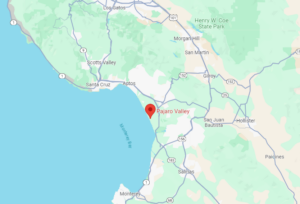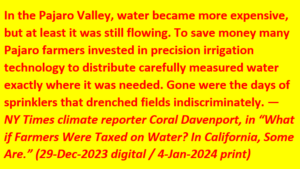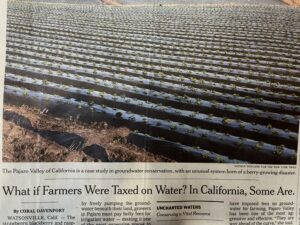Please admit California’s Pajaro Valley to the storehouse of evidence that charging a fee to use scarce resources can stretch those resources, to the benefit of all.
Never heard of Pajaro Valley? Me neither, until I came across NY Times climate reporter Coral Davenport’s compelling end-of-year story, Strawberry Case Study: What if Farmers Had to Pay for Water? Turns out I once hitch-hiked there en route to the spectacular Big Sur coast south of Monterey. But the payoff today is in the story’s subhead: With aquifers nationwide in dangerous decline, one part of California has tried essentially taxing groundwater. New research shows it’s working.

California’s Pajaro Valley, at center of this Google Map, hugs the Pacific Coast midway between Santa Cruz and Monterey and straddles the two counties named for those cities.
What’s working? A charge for groundwater extracted to grow strawberries, raspberries, brussels sprouts, lettuce and kale, administered by the state-chartered Pajaro Valley Water Management Agency to prevent saltwater from the adjacent Pacific Ocean from intruding into underground aquifers. The fee, which began several decades ago at a nominal $30 per acre-foot of water to recover PVWMA’s water-metering costs, now runs as high as $400, according to Davenport.
Lest that rise seem meteoric, and today’s price appear punitive, consider that currently the agency’s total annual water fees, $12 million, equate to barely 1 percent of annual Pajaro Valley crop revenues of $1 billion. What’s more, an acre-foot — the standard volumetric for water supply — is enormous, roughly 326,000 gallons. Even the projected 2025 groundwater fee of $500 per acre-foot translates to just 0.15 cents to a gallon, or a mere one-hundredth of a cent for an 8-ounce glass of water.
To be sure, that calculation is merely illustrative; water for drinking and water for growing crops are two different things. But consider what Pajaro Valley growers get from paying for water.
First, their payments are helping assure increased supplies of crop-worthy water. Revenue from the water fees enabled PVWMA to undertake a $6 million project that captures excess rainwater from a creek near the ocean and injects it into underground wells to be used for irrigation, and a $20 million water recycling plant that cleans 5 million gallons of sewage a day and pipes it to farm fields. Next up, Davenport tells us, is an $80 million system to capture and store more rainwater for irrigation. By replenishing and “stretching’ supplies of groundwater, these investments help ensure that brackish water from the ocean doesn’t seep into Pajaro Valley wells.
 Just as importantly, the growers receive a potent incentive to use available water supplies more efficiently. “Gone were the days of sprinklers that drenched fields indiscriminately,” Davenport writes. “To save money, many Pajaro farmers invested in precision irrigation technology to distribute carefully measured water exactly where it was needed.” (See text box.) Though the article doesn’t mention it, these investments by dozens of individual growers might not have materialized had not all growers been subject to the same incentives to conserve as well.
Just as importantly, the growers receive a potent incentive to use available water supplies more efficiently. “Gone were the days of sprinklers that drenched fields indiscriminately,” Davenport writes. “To save money, many Pajaro farmers invested in precision irrigation technology to distribute carefully measured water exactly where it was needed.” (See text box.) Though the article doesn’t mention it, these investments by dozens of individual growers might not have materialized had not all growers been subject to the same incentives to conserve as well.
Economics
Undergirding Davenport’s upbeat reporting is a 2023 working paper, The Dynamic Impacts of Pricing Groundwater, by three economists at U-C Berkeley’s Dept. of Agricultural and Resource Economics. In academic parlance, “dynamic” doesn’t connote a Marvel superhero, it refers to changes over time. By examining changes in water usage over time, the authors conclude that each “21% price increase led to a … 22% reduction in average annual groundwater extraction” by Pajaro Valley growers.
The implied price-elasticity is roughly negative 1.3. (The paper helpfully reports that “The reduction in annual water use doubles between the first year and the fifth year after the tax, with the implied price elasticity of demand ranging from negative 0.86 to negative 1.97.) This empirically-derived price sensitivity is far greater than the price elasticities assumed in CTC’s carbon-tax model, befitting not only the greater salience of water use for growers vis-a-vis energy use for consumers and even most businesses, but the greater agency of Pajaro Valley growers who, Davenport’s reporting suggests, over time have increasingly bought into PVWMA’s groundwater fee in both theory and execution.
 After reading Davenport’s article I reached out to hydrologist, climatologist and water sustainability expert Peter Gleick, whose latest book, The Three Ages of Water: Prehistoric Past, Imperiled Present, and a Hope for the Future, was published last year by Hachette / Public Affairs. Peter praised the article while preferring to denote the PVWMA groundwater charge “not [as a] tax but a fee or simply a price for a commodity.” He added, “When we pay for something, we’re more conscious of how we use it. When something is free, we’re more likely to misuse and abuse it. That’s certainly been the case historically for California groundwater.”
After reading Davenport’s article I reached out to hydrologist, climatologist and water sustainability expert Peter Gleick, whose latest book, The Three Ages of Water: Prehistoric Past, Imperiled Present, and a Hope for the Future, was published last year by Hachette / Public Affairs. Peter praised the article while preferring to denote the PVWMA groundwater charge “not [as a] tax but a fee or simply a price for a commodity.” He added, “When we pay for something, we’re more conscious of how we use it. When something is free, we’re more likely to misuse and abuse it. That’s certainly been the case historically for California groundwater.”
Carbon Taxes?
A number of posts in this space have touted — we might say “flogged” — other instances of resource or externality pricing, as possible templates for large-scale carbon pricing. In 2016 we wrote about Berkeley’s soda tax, actually a tax on the sugar content of soft drinks, and summarized research showing that sales of sugar-sweetened beverages fell 21% in that city while rising 4% in “control groups,” i.e., neighboring municipalities where soft drinks continued untaxed. Last year we explained why Congestion pricing, coming soon to New York City, could bode well for carbon-taxing — a message we previously broadcast several times in 2019 as the enabling legislation was being enacted in Albany, in March and in April.
We also dug deep in 2017, writing about an incipient NYC nickel fee on carryout bags dispensed at supermarkets, grocery and convenience stores. (The fee was a month away from taking effect, and though we haven’t yet seen before/after comparisons, anecdotal evidence suggests that trees in New York City are today far less encumbered by windblown plastic bags that we referred to then as “gossamer debris stuck, like tumors, to our half-a-million street trees.”) We can also go back half a century, to 1972, when NYC environmental officials conjured a “dirty oil surcharge” that forced petroleum suppliers to cough up a fee for each barrel of high-sulfur oil they brought into the city, a remarkably successful (but little known) instance of externality pricing that I memorialized in a 2009 post for Grist, Pollution Taxes Work.
Needless to say, none of these fees — not the soda tax, not congestion charging, not the carryout bag fee, and not the dirty oil surcharge — has paved the way for full-on carbon pricing. While each of them has been or will be a resounding success, their scale is far too local and the stakes far too small to translate automatically to national or even state-level carbon pricing. The same will hold for California’s Pajaro Valley groundwater fee. Indeed, California water districts are wrestling today with the hard work of fulfilling a state mandate requiring every part of the state to devise a plan to conserve groundwater.
Happily, Davenport notes that PVWMA officials and even some growers are advising their statewide counterparts to emulate their approach, including “local control” rather than state or even county governance. Dedicating the groundwater-fee revenues to investments to expand and extend supply, as Pajaro Valley has done, seems a no-brainer.
Less happily, Davenport notes that the Westlands Water District, which serves the state’s giant Central Valley breadbasket, is pushing a plan “that would allow growers to pay for credits to use groundwater above a certain allocation.” The growers “could buy and sell the credits, starting at about $200 a credit,” Davenport notes. While this scheme certainly improves on the status quo of charging little or nothing for groundwater use, it’s complicated and drenched in market ideology, much as carbon cap-and-trade systems needlessly encumber what could and should be straightforward carbon pricing.
Let’s not end on that dour note, however. All instances of resource charging — whether to stretch a limited resource or to internalize pollution or other externality costs — make it easier to build support for enacting new ones. Davenport’s story — here’s the link again — is both brilliant reporting and cause for optimism.
We close with a snap of the story opening and photo as they appeared on the front page of today’s (Jan. 4, 2024) Times, above the fold. Below it are calculations in which we derived figures in the first part of this post.

Calculation #1: Glasses of water in an acre-foot.
- One acre = 43,560 ft^2, so one acre-foot = 43,560 ft^3.
- One ft^3 (cubic foot) contains 957.5 fluid oz. (per inchcalculator.com; that figure jibes with the 62.4 lb weight of one cubic foot of water).
- A standard water glass contains 8 fluid oz. Thus, one ft^3 of water can fill 957.5/8 = 120 glasses.
- One acre-foot then contains enough water to fill 43,560 x 120 = 5.2 million glasses. Spreading a per-acre foot charge of $500 over that many glasses computes to 0.01 cents each.
Calculation #2: Groundwater-use price-elasticity inferred from empirical finding that a 21 percent price increase evokes a 22 percent decrease in usage.
- It is tempting to reduce this roughly 1-to-1 relationship to a (negative) 1.0 price-elasticity. However, that would ignore the law of diminishing returns and, mathematically, the convex relationship between changes in price and changes in usage.
- The price-elasticity is derived by solving for e in the equation, (1 + 0.21)^e = (1 minus 0.22).
- Using base-10 logarithms, we have: e times log 1.21 = log 0.78, which (omitting one or two steps) leads to e = negative 1.3.

[…] Read More […]